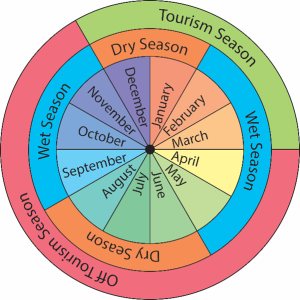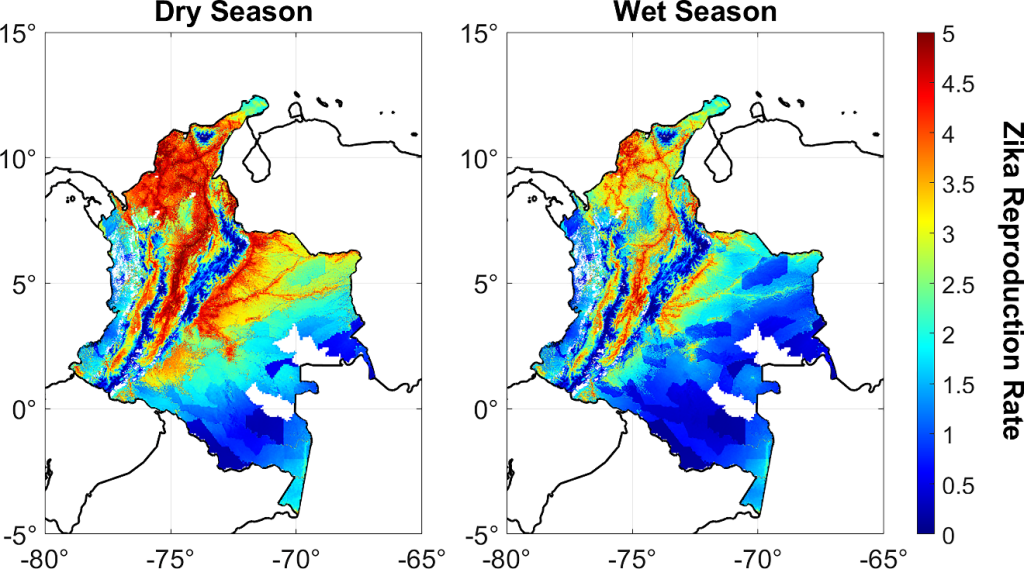
The Impact of Zika Virus in Colombia
How Seasons and Human Mobility Shape Epidemics
[Español]
by Julio Rodríguez Stimson
Background
Zika virus, belonging to the Flaviviridae family alongside dangerous viruses like Yellow Fever, Dengue, and West Nile Virus, is mainly transmitted by Aedes aegypti mosquitoes. In 2015-16, the Zika virus swept through the Caribbean and Latin America, causing over a million confirmed or suspected cases in humans. The epidemic caused widespread alarm due to its rapid spread across the globe, the established connection between Zika and birth defects, and the absence of vaccines to counteract the virus. The Zika virus cast a shadow over the 2016 Brazil Olympics and was overall a major detriment to the tourism industry throughout the region, costing the industry up to $18 billion by some estimates.
A team of interdisciplinary researchers from the University of Maine and University of Illinois Urbana-Champaign, working on the NSF-funded Coupled Dynamics of Tourism and Mosquito-Borne Disease Transmission in the Americas project, have shed light on the factors that drive the severity of Zika outbreaks. Through data analysis and computational simulations, they revealed the critical link between seasonality and human mobility in the spread of epidemics, using Colombia as a case study. Lead researcher, Dr. Brandon Lieberthal, stated that:
Seasonal Dynamics
One of the key takeaways from the research is that seasonal factors play a significant role in the severity and trajectory of Zika virus epidemics. During dry months mosquitoes are more abundant, which could lead to more super-spreader events. In the wet season, despite relatively lower abundance of mosquitoes, super-spreading may also occur in regions that are reliant on the tourism industry because of increased human travel.
By employing spatial modeling to track mosquito presence and network modeling to analyze human mobility, researchers found that the month in which Zika virus is introduced into the system can have a profound effect on the overall course of the epidemic. The study suggests that had Zika been introduced in January 2016, just three months later than its actual arrival in October 2015, the potential impact could have been significantly higher. Up to 60% more people could have been infected, and there could have been a 40% increase in super-spreader events. This is attributed to the coincidence with a dry season month characterized by elevated tourism rates.


Human Mobility
Globalization and the spread of mosquitoes like Aedes aegypti and Aedes albopictus have paved the way for arbovirus introduction and transmission, and increased human mobility is a key factor in determining the spread of the Zika virus. Modeling human movement can be challenging, but researchers used cellphone data, social media posts, air travel records, and migration papers to generate a more accurate picture of people moving within Colombia and its relationship to the virus. Other important factors include socioeconomic data such as land use and road density, as well as network factors such as connectivity and centrality.

Implications for Public Health
The study’s findings have significant implications for public health planning and response. Understanding how environmental conditions and human mobility dynamics vary seasonally is crucial for effective disease control, especially for countries that depend on tourism.
- Environmental and human factors: Efforts to control arbovirus transmission should consider seasonal variations and human mobility.
- Disease Management: Countries that are highly reliant on tourism should examine the annual variation in climate and human mobility patterns to accurately estimate the prevalence and spread of outbreaks.
- Future Research: Simulations that involve habitat suitability of mosquitoes, human mobility, and seasonality can be replicated in other countries and inform future planning and allocation of resources for disease control.
Conclusion
The study’s exploration of Zika virus outbreaks in Colombia provides valuable insights into the complex interplay between seasonal factors and human mobility. By considering both environmental and human factors, we can better estimate habitat suitability for disease vectors and simulate disease outbreaks.
Arboviruses like Zika are an ongoing threat and understanding the drivers of their spread is essential. By studying the role of seasonal dynamics and human mobility, we can develop more effective strategies for disease prevention and control. This research is a step forward in our efforts to combat arbovirus outbreaks and protect public health.
